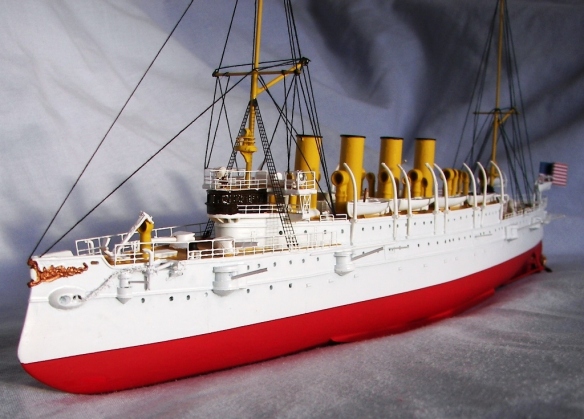
USS Columbia in 1898. She was designed as a fast commerce raider, specifically to catch fast ocean liners converted to armed raiders. Columbia’s comparative lack of heavy armament reduced her service life as the Navy’s strategy moved to command of the sea.
Only one cruiser was authorized in 1890, the USS Columbia. This ship and her sister ship, the USS Minneapolis, authorized in 1891, were enlarged Olympias. The increased hull length allowed three engines to be fitted, each linked to its own propeller. This gave the ships a speed of 23 knots and an ability to use only the central engine * and propeller for economical cruising. The role of these ships was commerce raiding, and they possessed the speed to f catch and overwhelm converted, armed liners. The success of their design was demonstrated when the Columbia outraced the German Hamburg liner Augusta-Victoria across the Atlantic in 1895, setting a record at just under seven days. Minneapolis and Columbia marked the end of protected cruiser construction and reliance on a commerce-raiding strategy
1890, like 1883, was a pivotal year for the US Navy. The maturing of the debate on naval strategy reflected on the growth of Germany, Italy, and Japan as naval powers. Additionally, Great Britain had passed the Naval Defence Act of 1889, establishing a two-navy standard, and had authorized construction of ten battleships and 42 cruisers. The naval building programs of France and Russia reflected the importance of battleships.
The publication of Mahan’s The Influence of Sea Power Upon History, 1660-1783 provided a historical context on the need for a battle fleet to achieve command of the sea. The building of the steel cruisers had provided the experience needed to design and build modern steel warships. Steelmakers had invested in new plants to manufacture armor plate and to supply the forgings for the manufacture of heavy guns. In 1890, the Washington Navy Yard conducted a test to determine which of the types of armor plate provided the best protection. An alloy of nickel and steel proved to be the strongest, and the following year, August Harvey, an American, invented a hardening process for this new alloy.
As Secretary Chandler had before him, Secretary Tracy appointed a policy board to recommend a fleet structure. This board recommended a two-ocean fleet with 35 battleships and 24 armored cruisers. As importantly, the policy board advocated a naval strategy for command of the sea approaches to the United States. The role of cruisers was detailed as “working as part of an integrated fleet” as well as commerce raiding. The ensuing political debate accepted the need for battleships and a new naval strategy. Three battleships, the USS Indiana, Massachusetts, and Oregon, were approved in 1890.
In April 1891, Tracy announced a new administrative policy for US Navy yards that removed hiring and firing from political patronage to a government-codified meritocracy. This critical development reflected frustration with the delays in the construction of the Maine and Texas.